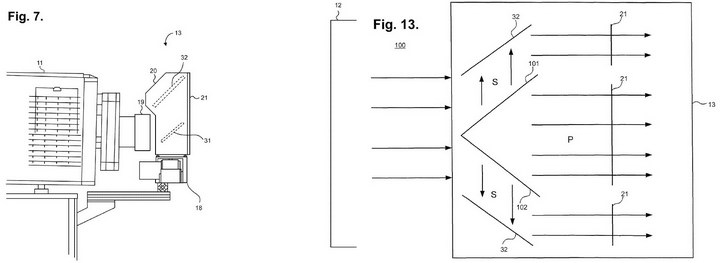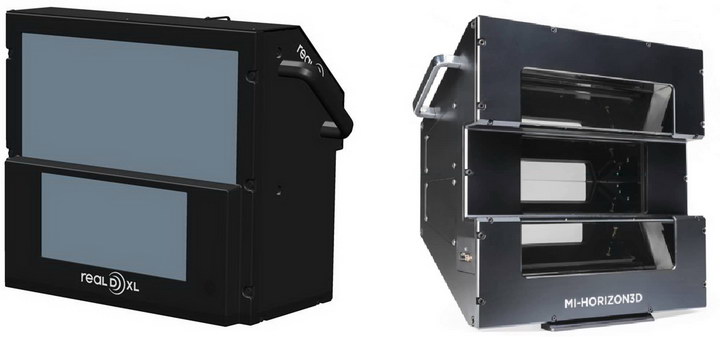On November 15th, Chris Ward and two of his colleagues at Lightspeed Design, Inc., were issued US Patent 9,494,805 titled “Stereoscopic Light Recycling Device.” Additional patents are either granted or pending in Canada, China, and Europe, according to the company.
DepthQ CineBright compared to a DepthQ modulator that does not use polarization recycling. The two boxes at the bottom are the drivers for the LC polarization modulator.
Lightspeed Design uses the brand name DepthQ for its stereoscopic projection products. This device, called CineBright by Lightspeed Design, is placed over the output of a projector that produces unpolarized light, e.g. a DLP projector, and uses a polarization conversion system to convert much of the unpolarized light to the desired polarized light for 3D projection with passive glasses. It is intended for digital cinema and will handle the output of a DCI projector that uses up to a 7kW Xenon lamp. The device is high frame rate (HFR) compatible, and will work at speeds of up to 240Hz. Switching time between frames is said to be 350uS, using a LC cell supplied by Lightspeed Design’s LC partner, LC-Tec Displays AB.
US 9,494,805 actually shows several different versions of the optical layout possible for the CineBright, two of which are shown in the figure below.

Figure 7 from the patent shows the CineBright unit attached to a DLP digital cinema projector. The unpolarized light comes out of the projection lens 19, is split by the polarizing beam splitter 31 into p-polarized light that is transmitted and s-polarized light that is reflected. The mirror 32 also includes a ½ wave plate to convert s light into p light. Both beams are modulated into left and right circular polarization by the modulator 21 and the two images are recombined at the projection screen 12. This is the version of the CineBright system that appears to be in production and is shown in the photo above.
In an alternative version shown in Figure 13 from the patent, the image light from the projector is split by two beamsplitters, 101 and 102 into one or two p beams, depending on how you count, and two s beams. The s beams are converted to p-polarization and all three or four beams are combined at the screen. The two top beams are overlaid on each other at the screen and edge matched to the two bottom beams. This beam combination at the screen in either the Figure 7 or the Figure 13 implementation is done using purely optical techniques – there is no video processing of the DCI video signal needed to overlay the images.
Figure 7 and the photo of the CineBright system look remarkably similar to the RealD XL Cinema System while Figure 13 looks remarkably similar to the MasterImage Horizon 3D system. Last July, the United States International Trade Commission (USITC) issued a final determination that the MasterImage Horizon violated RealD patents and could not be imported or sold in the United States. (Disclosure: I was an expert witness for MasterImage in that matter.)
 Left: RealD XL and Right: MasterImage Horizon systems. Both of these systems also perform the polarization recycling done by the Lightspeed Design DepthQ CineBright system.
Left: RealD XL and Right: MasterImage Horizon systems. Both of these systems also perform the polarization recycling done by the Lightspeed Design DepthQ CineBright system.
Lightspeed Design’s ‘805 patent does not cite any of the four RealD patents originally asserted against MasterImage in the lawsuit: US 7,959,296 filed Dec. 27, 2010; US 7,857,455 filed Oct. 18, 2006; US 7,905,602 filed Sep. 28, 2007; and US 8,220,934 filed Mar. 14, 2011. The Lightspeed Design ‘805 patent was filed on Jan. 21, 2014 so, presumably, all four of the RealD patents are prior art to the ‘805 patent. This lack of a citation for the prior patents is surprising – Lightspeed Design and their patent attorneys must have been aware of the existence of these patents. At least one of these patents should have been cited, with the goal of showing how a product based on the Lightspeed Design ‘805 patent would not infringe these prior-art patents.
In claim 1 of the ‘805 patent, one requirement is “…a single phase shifting optic comprising a reflective surface coated by a phase shifting film…” This reflective surface with the phase shifting coating is surface 32 in the above images. All of the other 21 claims in the patent are dependent on claim 1. This may make the patent valid in the face of RealD IP, since this is not a feature in the RealD patents. Having a valid patent does not automatically allow sale of the CineBright system, however.
Will RealD React?
I am neither an attorney nor a judge so I won’t give an opinion on whether any of the RealD patents will be sufficient to exclude Lightspeed Design from the US market with their CineBright system. I suspect quite strongly, however, RealD attorneys are examining the Lightspeed Design ‘805 patent and the publicly available information on the CineBright system Lightspeed Design has offered for sale, with an eye toward an injunction preventing sale in the US, as well as other countries where RealD has patents on the XL technology.
If the lawyers decide Lightspeed Design needs a license for the RealD patents in order to sell the CineBright system, I believe it is unlikely that RealD will grant it. They certainly fought hard enough to keep MasterImage out of the XL market.
DepthQ must be aware of the IP risks associated with this system because in the press release announcing the patent grant they say, “The DepthQ CineBright 3D high brightness passive polarization product is also covered by worldwide intellectual property insurance through Lloyd’s cover holder, Intellectual Property Insurance Services Corporation (IPISC). The minimum one million dollar policy was only made available after an extensive and sophisticated legal analysis, reviewed by independent third party intellectual property experts.”
I’ve never before seen a statement like this included in a press release announcing the issuing of a patent. Obviously, DepthQ is aware of potential issues with the validity of this patent as well as more serious issues related to the sale of the CineBright system in the US without a RealD License. Time will tell if these issues are realized or not. –Matthew Brennesholtz

